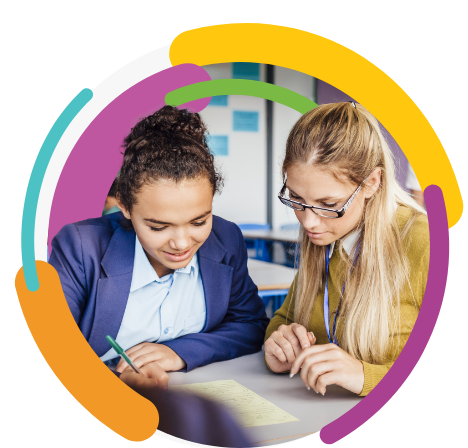
While many of us know the importance of social-emotional learning (SEL) for students, providing teachers with similar tools can be just as beneficial for schools – especially in a world that’s been turned upside down by COVID-19. Educators have always had their hands full but are now tasked with not only navigating the changes and uncertainty of the pandemic, but also supporting their students through this crisis. It’s become clearer that prioritizing the mental health of teachers is a critical component in addressing the needs of students and communities. To put it simply, if we don’t take care of teachers, we can’t take care of students.
One of the easiest ways to see the effects of not prioritizing teachers’ mental health is retention rates. While teacher turnover has been a pervasive problem in school districts throughout the country, with nearly 40% of all teachers leaving the profession within their first five years, rates have increased dramatically since the pandemic began. In fact, 1 in 4 teachers considered leaving their job in 2021. Teachers that leave the field cite many different reasons for their departures, but one of the biggest common themes is overall lack of support. So what can schools do to create a supportive environment for educators and keep them in the classroom?
The Link Between Teacher SEL and Retention
Many experts agree that the answer may be in SEL training and resources that allow administrators to support teachers’ mental health needs, demonstrating how valued and heard they are. A recent study from the Yale Center for Emotional Intelligence and the Collaborative for Social Emotional and Academic Learning (CASEL) of 5,000 teachers found that they are more in need of SEL than ever before, citing anxiety and stress related to the pandemic.
“Meeting the social-emotional needs of students, staff, and communities resulting from the COVID-19 pandemic is every educator’s number one priority,” explains Greg Walcott, author of Significant 72: Unleashing the Power of Relationships in Today’s Schools. “The past two years have not only brought about new levels of stress and anxiety, but have made more apparent the equity, financial, and learning gaps prevalent across the globe. This reality has left educators feeling unprepared to meet the needs of their students and themselves. Quality professional development during this time is crucial not only to student and staff well-being, but staff retention as well.”
Research supports Walcott’s position, with a strong link seen between SEL and teacher retention rates. CASEL reports that teachers with more highly developed emotional skills report greater job satisfaction and less burnout. These teachers also have better relationships with their students and administrators, creating an overall more positive work environment that fosters retention. With 80% of educators from across 15 countries stating that positive emotions and emotional well-being are crucial to success in the classroom, it’s clear that SEL can no longer be just for students if we want to slow down teacher turnover.
Teacher SEL in Action
Schools that know the true value of SEL take steps to ensure that this approach is implemented schoolwide, with a focus on adult learning serving as one of the key indicators that the school is taking a systemic approach to SEL. In these settings, staff have regular opportunities to cultivate their own social, emotional, and cultural competences, just as students are encouraged to do. Educators are also able to collaborate with one another, build trusting relationships, and maintain a strong community.
A schoolwide SEL approach doesn’t just mean creating a supportive environment, however; it’s important to take concrete steps to find ways to support staff SEL efforts. This can include encouraging teachers to create their own personalized SEL professional learning plans, creating a culture of appreciation, or implementing and modeling a growth mindset across the school. It can also include providing dedicated opportunities for teacher self-care and re-energizing, as well as putting in place other retention tools and programs for teachers to participate in.
One of the best – and most underutilized – SEL tools for teacher retention is coaching. Teacher coaching creates a personalized path for educators to develop the skills they need to manage the daily stresses of teaching. It allows teachers to focus on their social-emotional needs, increasing their confidence in both their teaching abilities and their ability to handle stressful situations. By giving teachers the tools they need to focus on their mental health, they’ll feel more confident facing new challenges and ultimately staying in the profession.
Incorporating SEL into other programs like mentoring, professional development, and teacher leadership opportunities can also help to build a stable workforce and minimize teacher turnover. In the same way that teachers are encouraged to gain professional skills, they should be encouraged to develop social-emotional skills – especially new teachers. “The more supported teachers are in their early careers, the more likely they are to stay in the profession,” explains Laurie VanderPloeg, Director of the U.S. Office of Special Education Programs.
With teachers ranking personal resources to support mental and physical health as the second-most helpful contribution in educator well-being, second only to more personal time throughout the day, it’s clear that establishing formal SEL programs is worth the investment. SEL opportunities like coaching programs and mentorships should be easy for teachers to access, demonstrating not only that their hard work is appreciated, but that there are programs in place to help them keep growing within their roles.
Final Thoughts
While students will always be the focus of education, it’s important to ensure that teachers are taken care of too. Just as students need a safe emotional environment to learn, teachers need to know their mental health is a priority to provide the best education to their students. Investing in SEL programs not only creates better learning outcomes, but also fosters an environment that teachers are happy to work in for years to come.
Recent Blogs
- What’s New and Next at FACTS: Q2 Product Roadmap Update
- Every Club Counts: Bringing Custom Apparel and Spirit Wear to All Student Programs
- Unlocking School Security: Why Schools Need a Visitor Management System
- Why School Fee Transparency Matters
- What You Need to Know About the ECCA: A New Federal Opportunity for School Choice


